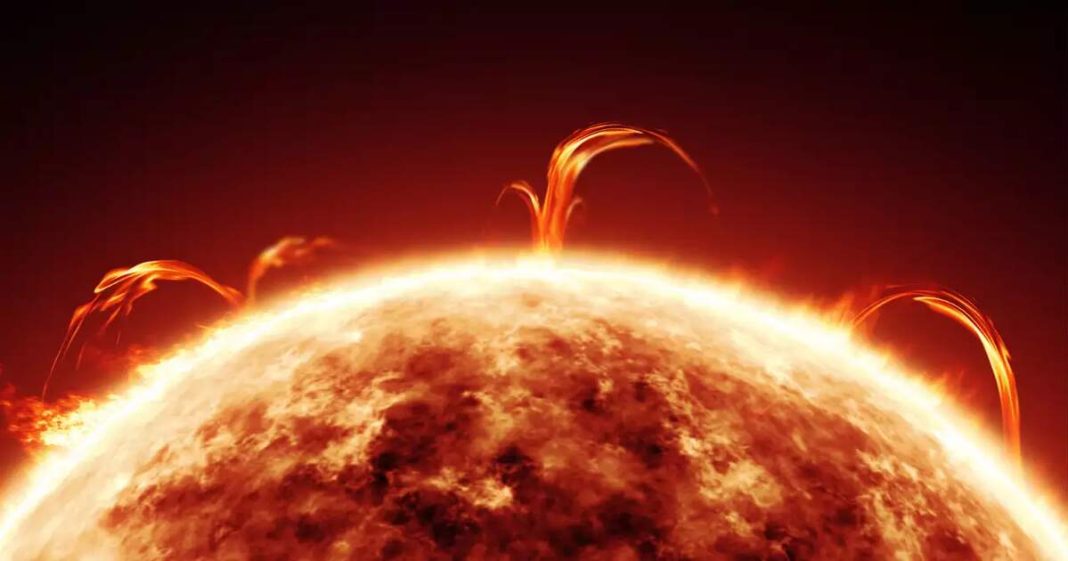An intense solar storm triggered by a powerful flare from the sun has reached Earth, and officials from the U.S. National Oceanic and Atmospheric Administration (NOAA) are warning that it could escalate to “extreme” levels. As the storm unfolds, it poses significant risks to power grids, GPS systems, and radio communications, while also providing a rare opportunity to witness auroras much farther south than usual.
Severe Geomagnetic Storm: A Solar Flare’s Aftermath
The storm began when a coronal mass ejection (CME)—a massive cloud of charged solar particles—slammed into Earth’s magnetic field. According to NOAA’s Space Weather Prediction Group (SWPC), the CME struck around midday, immediately triggering a G4-class geomagnetic storm. This class of storm is considered “severe,” with the potential to disrupt critical infrastructure on Earth.
Read More: Solar storm set to disrupt power grids and GPS
“There’s a possibility that we could reach G5 (Extreme) levels, which would bring even more intense disruptions,” NOAA officials cautioned. The storm, which started on Thursday, is expected to last until Friday, Oct. 11, raising concerns about its impact on electrical systems and global communication networks.
Power Grid and Communication Disruptions
The potential for infrastructure damage is a major concern. Geomagnetic storms can interfere with power grids, especially those that are already weakened, like in Florida and North Carolina, which have been impacted by hurricanes Helene and Milton. The storms could exacerbate ongoing recovery efforts in these regions, with NOAA warning that additional stress on power systems could lead to widespread outages.
“Power grids already under strain due to recent hurricanes are more vulnerable during this geomagnetic storm,” the SWPC noted. The geomagnetic activity could cause voltage irregularities, leading to temporary or even prolonged blackouts in areas already struggling with the after-effects of extreme weather.
Communications could also face disruptions. GPS signals, which rely on satellites in low-Earth orbit, may become unreliable or entirely lost. Similarly, high-frequency radio communications, often used by pilots and emergency response teams, could be impacted, creating additional challenges for both everyday operations and disaster recovery.
Auroras Light Up the Skies in Unlikely Places
While the storm threatens technology, it also offers a spectacle to skywatchers. According to NOAA, the auroras—commonly visible only in high-latitude regions like Scandinavia and Canada—may be seen much farther south. Areas as far south as Alabama and northern California are expected to witness brilliant northern lights.
“When skies are clear, auroras could appear in unexpected locations,” SWPC officials said. This follows a similar event in May when a solar storm produced dazzling auroras that extended into southern U.S. states.
Solar Storms on the Rise
The current solar storm is not an isolated incident. It follows a series of solar flares over the past week, including an X1.8-class flare, one of the most powerful eruptions the sun can produce. These events are part of the solar maximum, the most active phase of the sun’s roughly 11-year cycle. Although this maximum was initially predicted to occur in 2025, some scientists believe we may already be experiencing it.
NOAA has been in close contact with federal and state agencies, including FEMA, to manage the potential fallout. They will continue to monitor the storm, providing real-time updates on its progression and any increased threats to infrastructure.
Read More: Earth to Have a New Temporary Moon
As the storm continues into Friday, NOAA advises anyone hoping to catch a glimpse of the northern lights to head away from city lights for the best viewing experience. While the storm brings challenges, it also provides a stunning natural display for those in its path.














